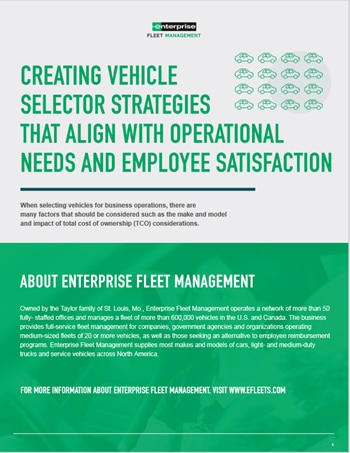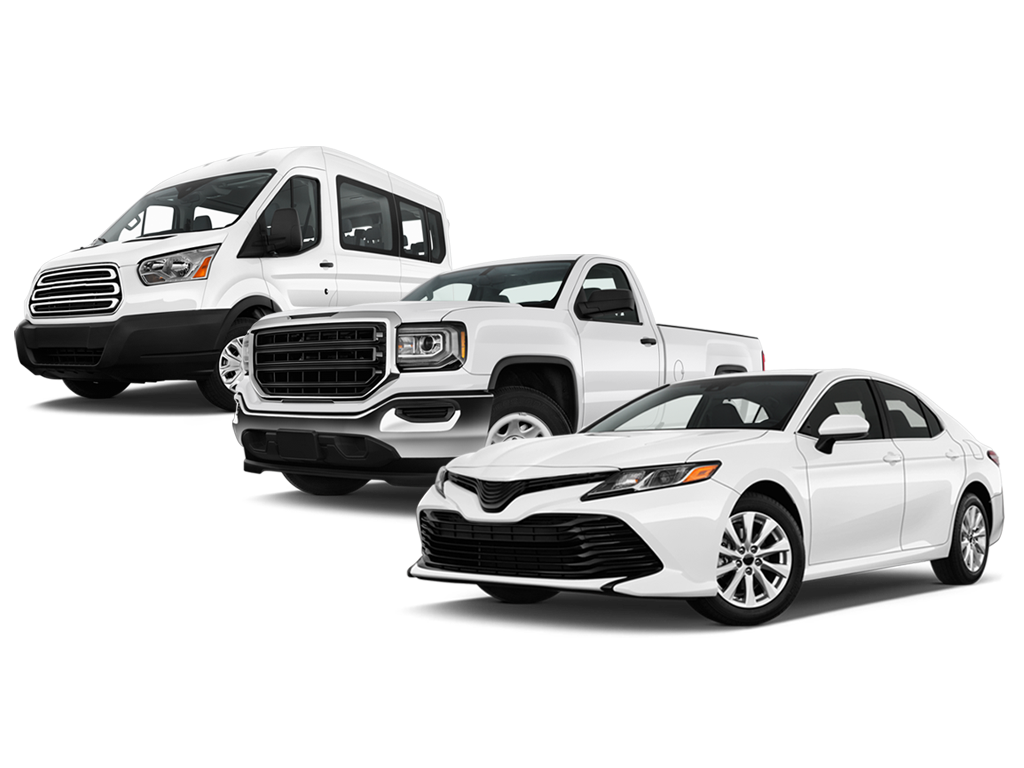SELECTING THE RIGHT VEHICLES FOR YOUR BUSINESS
Once your vehicle policy is established, the next step is to consider which vehicles will be offered to employees. Vehicle selection often depends on your industry, location, company sustainability efforts, and the specific requirements of an employee’s job.
If you operate a large fleet with employees performing different jobs, consider creating a tier system that distinctly separates vehicles based on job function, position, department, responsibilities, and required duties. Using a tier system, the fleet’s vehicle selector could include a range of base to high-end vehicles assigned to employees based on their position in the company. For example, an entry-level sales executive may be assigned a small sedan that can be traded in for an SUV when the employee is promoted to field manager, and then traded later for a luxury, full-size sedan when the field manager is promoted to an executive position. As a result, the vehicle serves as both a reward and an indicator of the employee’s rank as he or she progresses within the company.
It’s also important to keep weather and geography in mind when selecting vehicles for your business. Will your vehicles be operating over gravel or partially paved roads at a job site? Will your fleet vehicles be driving in 100-plus degree heat or will the vehicle face elements in all four seasons? Will the vehicles be operating at higher elevations or at sea level? Will employees be driving on the highway or building up inner-city mileage? All these scenarios have an impact on replacement strategies and resale value that you’ll want to consider. You’ll also need to think about any aftermarket equipment or vehicle modifications that will need to be added to the vehicle to serve your business, clients and employees. Will ladder or utility racks need to be added? Will the driver require extra storage space or customized towing capabilities? These are all factors that contribute to the type of vehicle the employee will be assigned whether it’s a cargo van, pickup truck, or SUV.
If your company is concerned about sustainability, integrating vehicles that have a lower environmental impact, such as electric vehicles (EV) or hybrids may be a solution to consider.
Many fleet management companies offer voluntary Carbon Reporting and Offset programs to help determine the company’s emissions impact. Access to fleet solutions like carbon offset reporting, maintenance programs, fuel efficiency and data analytics will help calculate the fleet’s overall sustainability performance.
Finding the optimal vehicle to safely meet the operational needs of the business and balance the cost to operate is a challenge most organizations face. As part of identifying the types of vehicles to best meet the operational needs of the fleet, total cost of ownership (TCO) must be considered. Companies often struggle with calculating true total cost of ownership without knowing how long they are expected to or plan to keep a vehicle in service, knowing how often it will be used, future maintenance and fuel costs, and the vehicle resale value when it’s sold.
The process of selecting a vehicle and determining its TCO is not a one-size-fits-all formula. Every fleet, even those in the same industry, is different, meaning vehicle options should be based on the individual business. This is where a professional fleet management company, like Enterprise Fleet Management, can help an organization make an informed decision. Enterprise Fleet Management has the resources to assist in decision making — by considering all the individual factors each organization faces; such as new vehicle make and model options and pricing, remarketing history and projections, as well as the experience and knowledge gained from managing the largest fleet in the world. These strategies and know-how are applied to help determine the vehicles clients select for their business needs and employees.
Enterprise Fleet Management’s Account Managers are experienced in fleet management, as many began their careers managing Enterprise Rent-A-Car branch fleets. As a result, each Account Manager has extensive experience strategically managing a fleet of vehicles.
Enterprise Fleet Management, together with its affiliate Enterprise Holdings Inc., operates the largest privately-owned fleet of vehicles in the world and has a wealth of data and industry expertise that each Enterprise Fleet Management Account Manager has access to.
INVOLVING EMPLOYEES IN THE PROCESS
When developing a vehicle selector list, the most successful organizations involve all the stakeholders throughout the process, including drivers. Since employees will be operating the vehicles each day, you’ll want to ensure they feel safe, secure, and proud. Most importantly, the vehicle should be upfitted properly to get the job done.
Gathering input can be as simple as having employees fill out a brief survey. An online survey will allow you to gather input anonymously, capturing employees’ honest opinions. The survey should focus on what’s important to them and functionally required for them to do their jobs (e.g., having ladder racks, 4WD, or towing capabilities). Online survey tools, such as Survey Monkey or Google Forms are affordable and easy to use and will help you give your employees a voice in the selection process.
While employee input is crucial to get a day-to-day perspective, you also need to weigh this against issues of TCO, functionality, and safety. For instance, an employee may want a crew cab pickup truck with leather seats and the best infotainment system, but when weighed against the day-to-day reality of the employee’s job (high miles and the need for specialized equipment) and the operational goals of the company, it’s likely not a practical option based on all the components of TCO, including depreciation.

